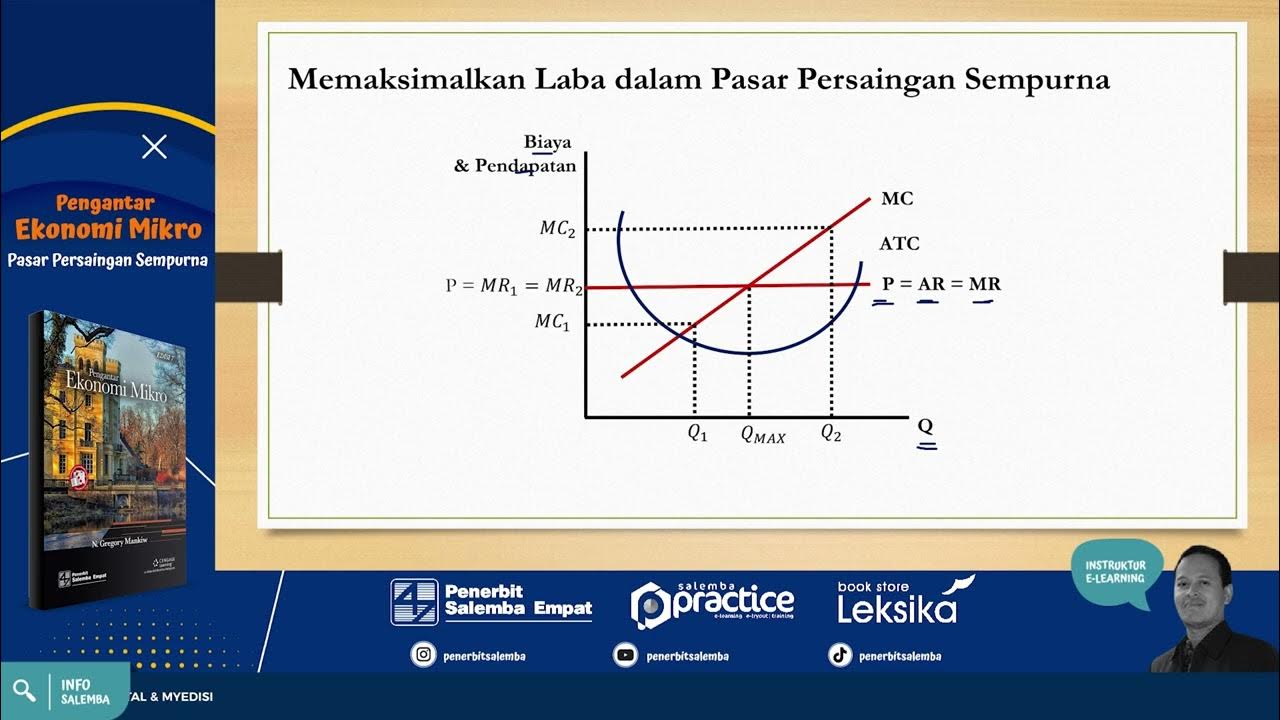Y2 7) Revenue - MR, AR & TR
Summary
TLDRThis video delves into revenue concepts, focusing on total, average, and marginal revenue. It explains key equations like Total Revenue (P x Q), Average Revenue (Total Revenue/Quantity), and Marginal Revenue (change in TR/change in Q). The script contrasts revenue curves in perfect competition, where firms are price takers, with imperfect competition, where firms are price makers. The speaker also covers the shape of revenue curves, showing that in perfect competition, revenue increases at a constant rate, while in imperfect competition, it rises and then declines. The video sets the stage for exploring profit next.
Takeaways
- 💰 Revenue is the money made from sales, and total revenue (TR) is calculated by multiplying price (P) by quantity (Q).
- 📊 Average revenue (AR) is total revenue divided by quantity, which simplifies to just the price.
- 📈 Marginal revenue (MR) is the extra revenue generated when one more unit is sold, calculated as the change in TR divided by the change in Q.
- 🏷️ In perfect competition, firms are price takers, meaning they sell goods at a constant price regardless of quantity.
- 🔄 TR in perfect competition increases at a constant rate, leading to a linear upward-sloping TR curve.
- 🔍 In imperfect competition (like a monopoly), firms are price makers, and the price decreases as more units are sold, following the law of demand.
- 📉 In imperfect competition, both AR and MR decrease as quantity increases, but MR drops twice as fast as AR.
- 🛑 Total revenue is maximized when MR equals zero. Beyond that point, additional units generate negative MR, reducing TR.
- 📐 AR in imperfect competition represents the demand curve, and it follows the linear equation form of P = a - bQ.
- 🔑 To maximize total revenue, firms should stop producing when MR becomes zero to avoid negative revenue impacts.
Q & A
What is total revenue (TR) and how is it calculated?
-Total revenue is the money made from sales by a business. It is calculated by multiplying the price (P) of the product by the quantity (Q) sold, using the formula TR = P * Q.
How do you calculate average revenue (AR)?
-Average revenue is calculated by dividing total revenue (TR) by the quantity (Q). Since TR is P * Q, average revenue simplifies to AR = P.
What is marginal revenue (MR) and how is it calculated?
-Marginal revenue refers to the additional revenue generated by selling one more unit of output. It is calculated as the change in total revenue (ΔTR) divided by the change in quantity (ΔQ), using the formula MR = ΔTR / ΔQ.
What do revenue curves look like in perfect competition?
-In perfect competition, firms are price takers, meaning they sell all units at the same price. As a result, both the average revenue (AR) and marginal revenue (MR) curves are horizontal and constant at the market price, reflecting that price remains the same regardless of quantity sold.
What are the key characteristics of a perfectly competitive market?
-A perfectly competitive market has many buyers and sellers, all firms sell identical (homogeneous) goods, firms are price takers, there are no barriers to entry or exit, and there is perfect information about market conditions.
How does total revenue change in perfect competition?
-In perfect competition, total revenue increases in a linear fashion as the quantity sold increases, since the price remains constant. The total revenue curve is an upward-sloping straight line.
How do revenue curves differ in imperfect competition compared to perfect competition?
-In imperfect competition, firms are price makers and face downward-sloping demand curves. Average revenue (AR) falls as quantity sold increases, and marginal revenue (MR) falls faster than AR, often becoming negative. These curves are downward-sloping, with MR being twice as steep as AR.
Why is marginal revenue (MR) twice as steep as average revenue (AR) in imperfect competition?
-When a firm in imperfect competition lowers its price to sell more units, it must reduce the price for all units, not just the additional ones. This leads to a larger drop in marginal revenue compared to average revenue, making MR twice as steep as AR.
Why is average revenue (AR) equal to demand in both perfect and imperfect competition?
-Average revenue is equal to the price of a good, and since price corresponds to demand in a market, AR represents the demand curve. Therefore, AR and demand are the same in both perfect and imperfect competition.
At what point is total revenue maximized in imperfect competition?
-Total revenue is maximized when marginal revenue (MR) equals zero. Beyond this point, MR becomes negative, meaning additional units reduce total revenue. Thus, TR reaches its peak when MR = 0.
Outlines

Этот раздел доступен только подписчикам платных тарифов. Пожалуйста, перейдите на платный тариф для доступа.
Перейти на платный тарифMindmap

Этот раздел доступен только подписчикам платных тарифов. Пожалуйста, перейдите на платный тариф для доступа.
Перейти на платный тарифKeywords

Этот раздел доступен только подписчикам платных тарифов. Пожалуйста, перейдите на платный тариф для доступа.
Перейти на платный тарифHighlights

Этот раздел доступен только подписчикам платных тарифов. Пожалуйста, перейдите на платный тариф для доступа.
Перейти на платный тарифTranscripts

Этот раздел доступен только подписчикам платных тарифов. Пожалуйста, перейдите на платный тариф для доступа.
Перейти на платный тарифПосмотреть больше похожих видео

Cara Menghitung Biaya Produksi, Penerimaan dan Laba Maksimum

Teoria da Firma / Parte 02

Pasar Persaingan Sempurna -Pengantar Ekonomi Mikro- #soaldanpembahasan #elearningplatform

Managerial Economics unit 3rd full revision class || Managerial economics unit 3rd MBA 1se semester

Video Pembelajaran - STRUKTUR PASAR DAN REVENUE (Kelompok 6)

Explaining Price Elasticity of Demand and Total Revenue - A Level and IB Economics
5.0 / 5 (0 votes)
